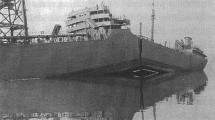Abstract
By analyzing heat transfer on the wall of flat steel ribbon wound vessel (FSRWV), a numerical model of temperature distribution on the entire wall (including inner core wall, flat steel ribbons, outside cylinder of jacket and insulating layer) was established by the authors. With the model, the temperature distribution and the length change in the vessel walls and flat steel ribbons in low temperature are calculated and analyzed. The results show that the flat steel ribbon wound cryogenic high-pressure vessel is simpler in structure, safer and easier to manufacture than those of conventional ones.
Similar content being viewed by others
References
Chen, G.B., 1989. Cryogenic Insulation and Heat Transfer. Zhejiang University Press, Hangzhou, p.240–256 (in Chinese).
Chen, Z.P., Jiang, J.L., 2004. The safety analysis of the cryogenic high flat steel ribbon wound pressure vessel. Cryogenics, 4:26–30 (in Chinese).
Chen, Z.P., Zheng, J.Y., 2001. Analysis of heat transfer and calculation of evaporation rate of flat steel ribbon wound liquid hydrogen high-pressure vessel. Cryogenics, 6:56–61 (in Chinese).
Jiang, J.L., 2001. Research on design of newly low temperature and high pressure vessel wound by steel strip. Cryogenics, 3:44–47 (in Chinese).
Lloyd, E.B., Edwin, H.Y., 1959. Process Equipment Design. John Wiley & Sons, Inc., New York.
Nichols, R.W., 1980. Developments in Pressure Technology-3, Materials and Fabrication. Applied Science Publishers Ltd., London, p.150–162.
Xu, L., 1995. Cryogenic Insulation Heat and Storage and Transportation Technology. Machine Press, Beijing, p.58 (in Chinese).
Zheng, C.X., 1997. Optimal design method of flat ribbon wound pressure vessel. Petro-Chemical Equipment, 1:14–19 (in Chinese).
Zheng, J.Y., Xu, P., Chen, C., 1998. Investigation on bursting pressure of flat steel ribbon wound pressure vessels. International Journal of Pressure Vessels and Piping, 75(7):581–587. [doi:10.1016/S0308-0161(98)00061-1]
Zheng, J.Y., Chen, Y.J., Deng, G.D., Sun, G.Y., Hu, Y.L., Li, Q.M., 2006. Dynamic elastic response of an infinite discrete multi-layered cylindrical shell subjected to uniformly distributed pressure pulse. Int. J. Impact Engineering, 32(11):1800–1827. [doi:10.1016/j.ijimpeng.2005.05.011]
Zhou, Y., 1998. Research and development of cryogenic vessel. Cryogenics, 4:15–21 (in Chinese).
Zhu, R.L., 1996. Potential developments of pressure vessel technology by using thin inner core and flat steel ribbon winding techniques. International Journal of Pressure Vessels and Piping, 65(1):7–11. [doi:10.1016/03080161(94)00067-S]
Zhu, G.H., Zheng, J.Y., 1995. New Type Flat Steel Ribbon Wound Pressure Vessel. Machine Press, Beijing, p.181–183 (in Chinese).
Author information
Authors and Affiliations
Corresponding author
Rights and permissions
About this article
Cite this article
Cui, Xl., Chen, Gm. Investigation on the temperature distribution and strength of flat steel ribbon wound cryogenic high-pressure vessel. J. Zhejiang Univ. - Sci. A 8, 210–215 (2007). https://doi.org/10.1631/jzus.2007.A0210
Received:
Accepted:
Published:
Issue Date:
DOI: https://doi.org/10.1631/jzus.2007.A0210
Key words
- Crogenic high-pressure vessel
- Flat steel ribbon wound vessel (FSRWV)
- Temperature distribution
- Numerical simulation




